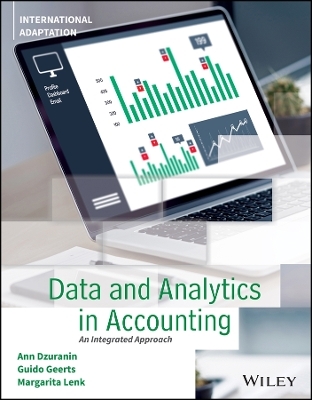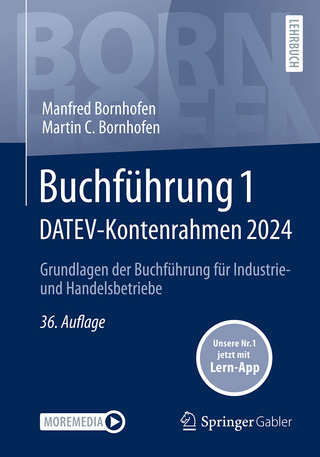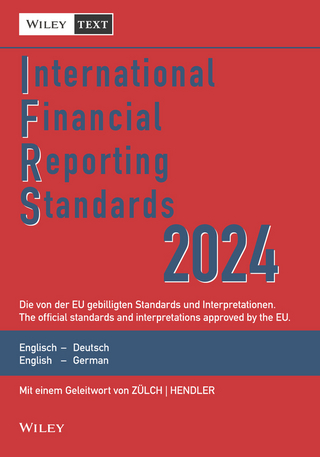
Data and Analytics in Accounting
John Wiley & Sons Inc (Verlag)
978-1-119-88912-0 (ISBN)
This international edition introduces a new feature “Data Analytics and Decision Making” at the end of the book, which offers students the opportunity to see how they can use data analytics to help solve realistic business problems. In addition, topical changes have been made in select chapters and brief exercises along with multiple-choice questions have been revised in all the chapters.
Ann Dzuranin is the KPMG Endowed Professor of Accountancy at Northern Illinois University. She earned her BS in accounting from Fairleigh Dickinson University, an MBA from New York University, and a Ph.D. from the University of South Florida. She is a CPA with 15 years of experience in both public and corporate accounting. Prior to pursuing her doctoral degree, she was the director of management accounting and international reporting for a Fortune 100 financial service company. Guido Geerts is a professor and Ernst & Young faculty scholar at the Lerner College of Business, University of Delaware, where he teaches accounting information systems and big data technologies. Guido has received numerous awards for excellence in teaching, research, and service, and is the former chair of the Technology Task Force for the Pathways Commission Recommendation 4. He previously served on the American Institute of Certified Public Accountants (AICPA) Academic Executive Committee (AEC) and currently serves as a trustee of the AICPA Foundation. He is the 2022 recipient of the AAA/J. Michael and Mary Anne Cook/Deloitte Foundation Prize for outstanding undergraduate professor. Margarita Lenk was an associate professor at Colorado State University. Her areas of expertise include data analytics; machine learning; accounting information systems; controllership; enterprise risk management; governance and internal controls; and sustainability accounting. Professor Lenk taught accounting courses at the undergraduate and MACC program levels. She is a national consultant on curricular reforms and a regular presenter at the American Accounting Association conferences on data analytics. Professor Lenk’s articles have been published widely and she has won over 20 teaching awards, including a AAA/Michael J. and Marianne Cook/Deloitte Prize for outstanding undergraduate professor.
1 Data and Analytics in the Accounting Profession
1.1 How Are Data and Analytics Transforming the Accounting Profession?
1.2 What Are the Stages of the Data Analysis Process?
1.3 What Is a Data Analytics Mindset?
1.4 How Is a Data Analytics Mindset Applied?
2 Foundational Data Analysis Skills
2.1 How Does Understanding Data Storage Help Answer Questions?
2.2 How Do Spreadsheet Functions Analyze Large Amounts of Data?
2.3 How Do We Organize Data Sets for Analysis?
2.4 Which Descriptive Measures Help Us Understand Data?
2.5 How Is Visualization Used in Data Analysis?
3 Motivations and Objectives for Data Analysis
3.1 How Does Motivation Inform Objective-Based Data Analysis Questions?
3.2 What Are Descriptive Objectives?
3.3 What Are Diagnostic Objectives?
3.4 What Are Predictive Objectives?
3.5 What Are Prescriptive Objectives?
3.6 What Are Data Analytics Motivations and Objectives in Professional Practice?
4 Planning Data and Analysis Strategies
4.1 How Do Accountants Design Data Analysis Projects?
4.2 What Should We Consider When Selecting Data for Analysis?
4.3 What Should We Consider When Selecting an Analysis?
4.4 How Do Data and Analysis Strategies Differ Across Practice Areas?
5 Analysis: Data Preparation
5.1 What Is Data Profiling?
5.2 What Does It Mean to Extract-Transform-Load (ETL) Data?
5.3 Which Patterns Extract Data?
5.4 Which Patterns Transform Columns?
5.5 Which Patterns Transform Tables?
5.6 Which Patterns Transform Models?
5.7 Which Patterns Apply to Data Loading?
6 Analysis: Information Modeling
6.1 What Is Information Modeling?
6.2 Which Patterns Implement Information Modeling Algorithms?
6.3 Which Patterns Help Develop and Implement Accounting Information Models?
7 Analysis: Data Exploration
7.1 What Is Data Exploration?
7.2 How Are Data Relationships Visualized for Exploration?
7.3 How Are Data Explored by Integrating Data Relationships?
8 Interpreting Data Analysis Results
8.1 How Do We Draw Conclusions from Data Analysis?
8.2 What Is the Relationship Between Critical Thinking and Data Analysis Interpretation?
8.3 How Do We Know the Analysis Makes Sense?
8.4 How Are Validity and Reliability Determined in Descriptive and Diagnostic Analyses?
8.5 How Are Validity and Reliability Assessed in Predictive and Prescriptive Analyses?
9 Communicating Data Analysis Results
9.1 How Do We Tell a Data Story?
9.2 What Are the Steps for Creating Effective Data Visualizations?
9.3 What Are the Characteristics of Effective Visualizations?
9.4 What Makes Data Visualizations Misleading?
9.5 How Are Data Used in Live Presentations?
10 Recent Data and Analyses Developments in Accounting
10.1 Which Data Trends Are Impacting Accounting Practice?
10.2 Which Recent Analyses Developments Are Accountants Adopting?
10.3 How Are Data and Analyses Developments Impacting the Professional Practice Areas?
| Erscheinungsdatum | 22.12.2022 |
|---|---|
| Verlagsort | New York |
| Sprache | englisch |
| Themenwelt | Wirtschaft ► Betriebswirtschaft / Management ► Rechnungswesen / Bilanzen |
| ISBN-10 | 1-119-88912-X / 111988912X |
| ISBN-13 | 978-1-119-88912-0 / 9781119889120 |
| Zustand | Neuware |
| Haben Sie eine Frage zum Produkt? |
aus dem Bereich


